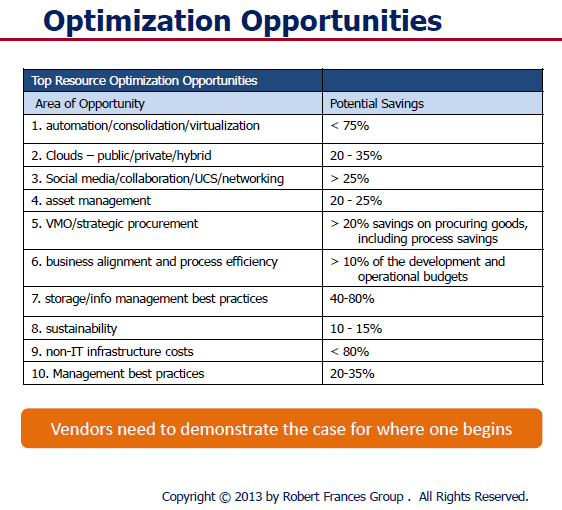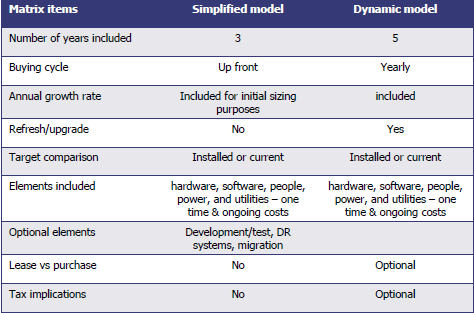What did I learn (or what did you miss) at Disrupt 2014?
On Monday I attended The Robert Frances Group’s (RFG) Disrupt 2014 conference in New York City. The attendees enjoyed an over-the-top lunch and several hours of interesting and informative presentations. I would probably gain weight just recounting the menu, so instead I’ll review two of the presentations, and hint at a third.
1 – IT Disruptive Tech Trends and Directions
With this as the title, Cal Braunstein, CEO and Executive Director of Research for RFG, began by showing us how the pace of disruptive technology is increasing dramatically. According to AIIM, for more than 1/3 of the organizations studied, 90% of their IT spend adds no new value. It was the right start for Disrupt 2014.
IT budgets are increasing linearly, at 1-5% per year, while the data we produce is increasing exponentially. Disruption isn’t just necessary, it is critical!
What is disruption? RFG defines it as industry leaders responding to the changes in customer demands and global economics by making fundamental changes in their approach to products, services, service delivery, engagement models, and the economic model on which their industry is based. You can read more about it here.
Cal focused on Storage Trends and Directions as a bellwether of disruption.
 Intel conducted a study in 2012 that informed part of Cal’s presentation. When looking at a data center and its technology, servers from before 2008 comprised 32% of the hardware but they consumed 60% of the data center power budget. Here is the bad news. The old gear only provided 4% of performance capacity. The point is that the technology rate of change is exponential and any IT executive that keeps IT hardware past 40 months is costing his company money. Keeping current and transforming the data center over a 3 year cycle should be viewed as a strategic approach to modernizing a data center and containing costs. The improvement in processing power vs. power consumed is truly disruptive. You could pay for a data center renewal simply by scrapping the old power burning gear. RFG has identified the following optimization opportunities, which Cal presented.
Intel conducted a study in 2012 that informed part of Cal’s presentation. When looking at a data center and its technology, servers from before 2008 comprised 32% of the hardware but they consumed 60% of the data center power budget. Here is the bad news. The old gear only provided 4% of performance capacity. The point is that the technology rate of change is exponential and any IT executive that keeps IT hardware past 40 months is costing his company money. Keeping current and transforming the data center over a 3 year cycle should be viewed as a strategic approach to modernizing a data center and containing costs. The improvement in processing power vs. power consumed is truly disruptive. You could pay for a data center renewal simply by scrapping the old power burning gear. RFG has identified the following optimization opportunities, which Cal presented.
RFG has “Disrupt 2014” marching orders for IT
- IT departments must keep up with disruptive technologies
- Don’t wait for next wave to become mainstream – the time to act is now
- IT vision and strategy must include waves of change
- IT needs business and user executives to share the vision, integrate & buy-in
- Data Center transformation is a must and has a very positive business case
- IT vendors must show a business case, not just talk about products & services
2 – The Value of TCO Studies
 RFG Principal Analyst Gary McFadden presented on the value of Total Cost of Ownership (TCO) studies to support acquisition decisions. Gary’s Disrupt 2014 thesis was straightforward. According to Gary…
RFG Principal Analyst Gary McFadden presented on the value of Total Cost of Ownership (TCO) studies to support acquisition decisions. Gary’s Disrupt 2014 thesis was straightforward. According to Gary…
Businesses today are willing to invest provided they can see a decent return and a positive cost value proposition. Our TCO studies address the total cost of acquisition and ownership and the return on investment
In the RFG world, a TCO is a business-oriented custom research report that compares vendor offerings to those of their competitors. The report shows how the vendor’s solution could be financially superior to traditional approaches, and considers soft-dollar aspects as well as hard costs.
Knowing that, you should realize that all TCO studies are not created equal. Gary presented an overview of key TCO choices. Which one is right for you? Well, that depends on your needs. Your time horizon and buying cycle are chief determinants of which style of TCO would be right for you.
Making Sense of the Data
Gary correctly pointed out that no matter how comprehensive the data gathering phase of a TCO, the accumulated bulk of data is not actionable unless it is expressed in a useful manner. In the charts following, Gary contracted the details with an organized RFG presentation. The left chart holds mysteries, while the right one offers answers.
[table id=3 /]
Remember that all TCOs are not created equal. Make sure that the one you pay for delivers the information you need, and the ones you use in your research follow a robust development methodology and contain the insights you require to enable your decision.
By the way, don’t think RFG delivers vendor-slanted product and service stories. That is not what they are about. Instead, RFG’s TCO reports are targeted at business and technology executives including CIOs, IT VPs/directors, CFOs, CMO, facilities executives, etc. They relate a business narrative designed to explain the business case for taking certain actions.
3 – Storm Insights “Mystery Presentation”
No, I can’t tell you much. All I can say is that Dr. Adrian Bowles has an exciting and disruptive information services offering that will change the way IT product and services vendors learn about their markets, and the way their markets learn about them. Don’t write off traditional research and advisory services yet, but stay tuned. I’ll report about the Storm Insights offering as the new year unfolds. For now, take my word for it… this is very interesting!
The Bottom Line
Disrupt 2014 delivered great value and a great lunch to the appreciative attendees. RFG extended the hand of friendship and those that took hold learned much and enjoyed the sense of community that appears when like-minded professionals gather to exchange ideas. When RFG asks you to attend one of their meetings, the smart answer is “YES”!

